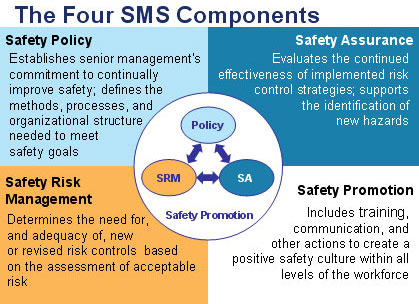Culture: The Foundation of a Safety Management System (SMS)

Detection vs. Prevention
Much has been written about the key elements of a Safety Management System (SMS).
According to the FAA, the key components are:
- Safety Policy – Establishes management’s commitment to safety. This includes policy, documented processes and hazard reporting.
- Safety Risk Management – Determines the need for and adequacy of risk controls. Includes risk assessment techniques and mitigation tools.
- Safety Assurance – Evaluates the continued effectiveness of implemented risk mitigation strategies and the identification of new hazards. Includes safety audits and data analysis.
- Safety Promotion – Training, communication and other actions to promote a positive safety culture. Includes education and lessons learned.

Source: https://www.faa.gov/about/initiatives/sms/explained/components/
But what if all these elements are in place and your organization still primarily practices “detection” rather than “prevention” when it comes to safety? In other words, what if you’re finding out about safety issues after they happen rather than anticipating and preventing them beforehand?
If your SMS is built on sand, it will wash away with the first strong wave. If it is built on a firm foundation, such as bedrock, it will withstand any force imposed upon it.
We recommend a pragmatic and reality-based approach to enhance your SMS.
Your Culture of Safety
Here is a checklist of simple but powerful items to look at relative to the organizational culture (the bedrock) beneath your SMS to determine whether it is sitting on firm footing.
Fear – Nothing undermines an SMS like fear.
What impact does fear have in your aviation organization? Can all team members really speak up when it comes to safety? Or are there unspoken “norms” that prohibit unfiltered sharing of perspectives? Does everyone feel comfortable “pulling the red cord” if they think something is wrong?
Start modeling the desired behavior by voicing safety concerns in department meetings where there are many of your team members present.
You’ve got to model the behavior before you can expect anyone else to.
Reinforcement – Are team members in your flight department acknowledged and rewarded when they openly voice a safety concern?
When this happens, be ready to use the tools that are available to recognize individual accomplishment, such as company reward programs (cash and otherwise), gift certificates, celebratory lunches, etc. And remember to acknowledge the positive behavior as soon as possible.
Inclusiveness – Are safety team meetings in your department shrouded in secrecy or are they open to everyone?
If you as the leader (or anyone else in the organization) can’t join a safety team meeting at your will, something is seriously wrong. The door should always be open (figuratively and literally) and everyone should feel welcome and encouraged to participate.
Participation – Are all the functional groups within your aviation operation involved equally in the deployment of the SMS?
Flight ops, MX, scheduling, business administration, regular contract staff and vendors, must all be informed on the appropriate use of risk assessment tools, submittal of hazard reports and the status of safety audits and reports. Look at the safety report submittals by functional group and assure yourself that a uniform SMS deployment has been established across the entire department.
Opportunity – Do you regularly rotate the role of safety manager to involve and make safety advocates of everyone in the department?
You must do all you can to combat the perception of “insiders” who can “control the message” of safety according to their own agenda. Rotate the safety manager role at regular intervals.
Motivation – Do you set “safety” as the primary organizational objective in every goal-setting cycle, both at the individual and organizational levels?
Meeting the department budget is “nice,” but it is subordinate to ensuring the highest levels of safety throughout the department. Adequate resources must be provided for your safety initiatives.
Advocacy – Are you personally involved as leader of the organization to champion safety? If so, can the same be said of each member in your leadership team?
Make overt and genuine safety advocacy a condition of membership on the leadership team. Watch for demonstrated behavior. Each of you needs to be the primary champions for safety. Remember, people are watching your feet not your mouth.
The Bottom Line
As aviation professionals, ensuring a safe operating environment is the most important thing we do. Providing the “sense of assuredness” that our passengers want and deserve is best accomplished by providing them with a safe and comfortable travel environment.
Is your SMS delivering the desired level of safety?
Is your organization’s culture appropriately serving your SMS program?
Maybe it’s time to check.

Gray Stone Advisors combines their experience both in leading businesses as well as business aviation operations to provide flight department leaders with proven strategies for excellence.
https://www.graystoneadvisors.com/
© 2024 Gray Stone Advisors. All Rights Reserved.
Next ArticleRelated Posts

More Than a Box Tick: Achieving Operational Flexibility With an FRMS
Moms know best. This adage holds true in many domains of family life—allergies, grades, crushes. When thinking about aviation safety, though, perhaps the best illustration drawn from mom’s expertise is…

The Effects of a Learning Mindset on Safety Culture
As aviation departments strive to enhance their safety performance, a critical yet often overlooked element is the need to foster a learning-culture mindset. This mindset shift can unlock invaluable opportunities for continuous improvement, employee engagement and creating a resilient safety environment. From a behavioral management perspective, as your company’s learning culture goes, so goes the ongoing success of your SMS.

